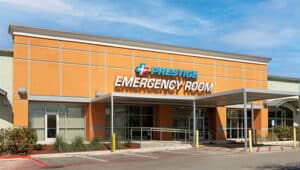ER Treatment for Shortness of Breath
Shortness of breath can be associated with several conditions, including asthma, pneumonia, COPD, or heart attacks. The hot, arid conditions of San Antonio summers can contribute to breathing problems. Cedar pollen season can also be a factor. If you are experiencing severe shortness of breath, you must seek immediate emergency care. Failure to do so can lead to respiratory failure or other complications, which can be fatal.
The team at Prestige ER is equipped to diagnose and manage your condition at any time of the day or night. Each of our four San Antonio locations offers state-of-the-art equipment and experienced staff who will provide you with prompt and personalized care.
It is essential to know when your shortness of breath is an emergency. Emergencies don’t wait, and neither should you.
You may wonder whether to go to the ER or urgent care for shortness of breath.
When to Go to the ER for Shortness of Breath
Shortness of breath—also known as dyspnea—can be frightening. It is often characterized by feelings of air hunger, tightness in the chest, or a sense of suffocation. Sometimes, shortness of breath can be caused by cold temperatures, vigorous exercise, or obesity. In other cases, it is a medical emergency.
But when is shortness of breath an emergency?
If shortness of breath occurs suddenly and interferes with your ability to function, it is important to get to an emergency room immediately.
Common Symptoms
Symptoms of shortness of breath include
- Wheezing.
- Inability to take a deep breath.
- Air hunger.
- Breathlessness.
- Tightness in your chest.
Severe symptoms include
- Nausea.
- Confusion.
- Chest pain.
- Pain in your arm or jaw.
- Chest pressure.
- Sweating.
- Cyanosis (a bluish tinge to the lips, face, or fingernails).
- Dyspnea when lying down.
- Fever and chills.
- Unresponsiveness.
- Dizziness.
- Fainting.
You may be asking, should I go to the ER for shortness of breath? You must seek emergency care if you or your family member are experiencing any of these symptoms.
Our trained clinicians can rapidly diagnose the cause of your symptoms and provide emergency treatment for shortness of breath.
What Will the ER Do for Shortness of Breath?
At Prestige ER, we will ensure you receive the help you need promptly. Your provider will discuss your symptoms, check your vital signs, perform a physical exam, and discuss your health history. A comprehensive medical history enables your provider to determine the cause of your symptoms (such as asthma or heart disease) and provide appropriate treatment.
Depending on your symptoms and risk factors, diagnostic testing may be ordered. This may include:
- Blood work.
- Chest X-rays.
- An EKG.
- An echocardiogram.
Based on your condition, we will provide the treatment you need, including oxygen or medications.
Our providers are equipped to manage a wide range of conditions. If you require surgery or hospitalization, we will transfer you rapidly by ambulance.
What Causes Shortness of Breath?
Asthma
A common cause of shortness of breath is asthma, which is caused by swelling and congestion in your airways. Common symptoms are shortness of breath and wheezing.
If you have asthma, you may take medication (such as an inhaler) to relieve and control your symptoms. Sometimes, in a severe asthma attack, you may need to get to an ER for shortness of breath. Asthma is prevalent in the San Antonio area: in 2020, approximately 12% of adults in Bexar County reported experiencing asthma.
COPD
COPD, or chronic obstructive pulmonary disease, is a chronic condition that restricts airflow in the lungs. It includes two distinct conditions: emphysema and bronchitis.
COPD is usually caused by smoking or exposure to particulate matter. Symptoms may include shortness of breath, coughing up mucus, wheezing, or fatigue. Exacerbations of COPD may require emergency care.
Pneumonia
Pneumonia occurs when the air sacs inside your lungs (alveoli) become inflamed and filled with fluid. Typical symptoms include cough, fever, shortness of breath, and chest discomfort.
During an exam, your provider will listen to your lungs with a stethoscope and may order a chest X-ray. Pneumonia can be bacterial or viral and is treated accordingly.
Heart Attack
Shortness of breath can sometimes be associated with a heart attack. In a heart attack, an artery supplying blood to the heart becomes blocked. Other classic symptoms include chest pain, pressure, sweating, and jaw or arm pain. Atypical symptoms may include nausea, indigestion, and back pain.
A heart attack is a medical emergency requiring rapid diagnosis and treatment.
Heart Failure
Heart failure, sometimes called CHF, results from the weakening of the heart muscle. It is the progressive inability of the heart to pump blood adequately. Symptoms may include shortness of breath, coughing, exercise intolerance, and swelling of the legs and ankles.
In some cases, heart failure can worsen suddenly and result in pulmonary edema—congestion of the lungs with fluid. Getting to an ER for shortness of breath caused by heart failure is critical.
Pulmonary Embolism
A pulmonary embolism is a blood clot that blocks blood flow through an artery supplying the lungs. The clot typically forms in a leg. Referred to as a deep-vein thrombosis, or DVT, this clot may travel to the lungs and cause a blockage.
Symptoms may include chest pain, rapid heart rate, coughing, shortness of breath, and fainting.
A pulmonary embolism can be life-threatening and requires emergency treatment.
Prestige ER offers prompt, expert emergency treatment for shortness of breath and other medical emergencies. Visit us at any of our four San Antonio locations today.












